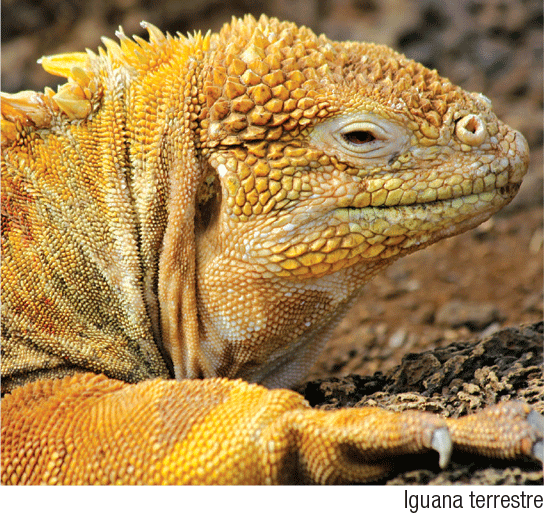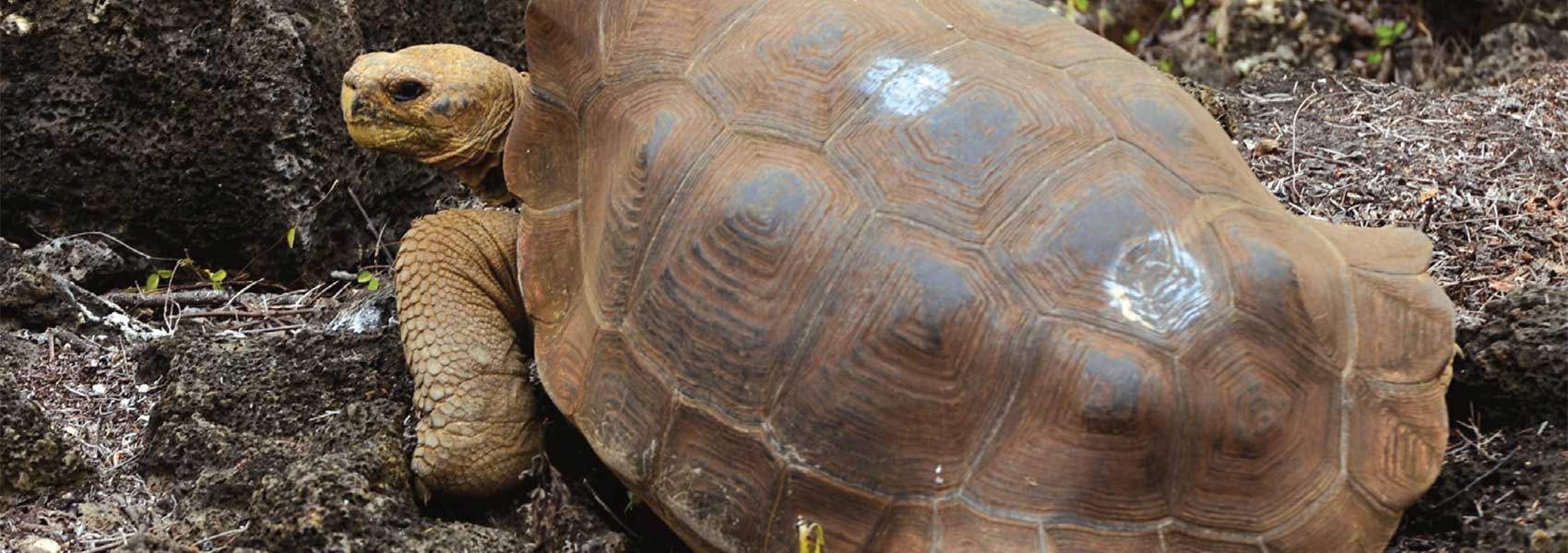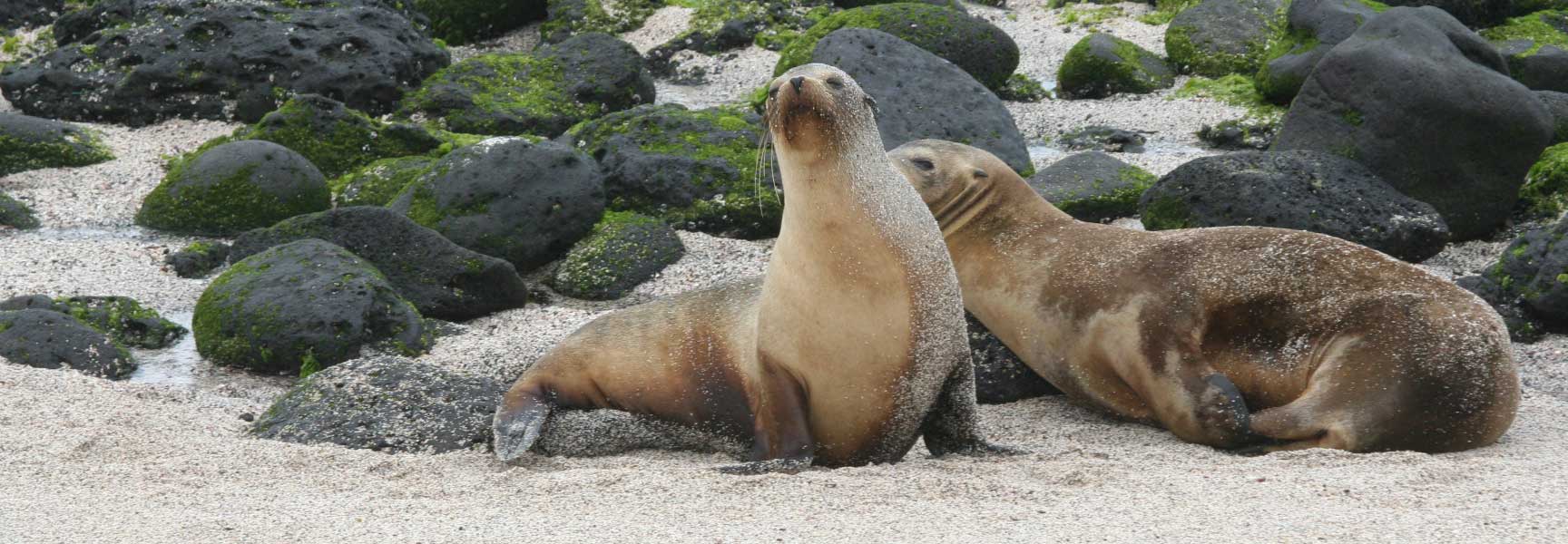
Description
Geography
Cultural
aspects
Biodiversity
Main
attractions
Activities
allowed
Existing
facilities
Documents and
recommendations
How to get?
Extraordinary flora and fauna, geological features and many unique species have made this park into a major global center for scientific research and nature tourism.
In recognition of its natural values it was declared a World Heritage Site by UNESCO in 1978. Despite all the problems it has faced, especially by organisms introduced from the mainland, is one of the best preserved archipelagos and a world leader in management of fragile ecosystems.
Galapagos includes two protected areas: the Galapagos National Park, covering 97% of the land area of the archipelago, and the Galapagos Marine Reserve, which protects the marine environment.
The most striking aspect of a visit to the Galapagos is to experience firsthand how animals have evolved in this parallel world, without knowing fear of humans. Not every park is open to tourism, but there is an extensive network of visitor sites specially designed to offer a close encounter with this 'natural laboratory' and at the same time, minimize environmental impact.
- Natural Heritage (Declared by UNESCO in 1978)
- Biosphere Reserve (declared by UNESCO in 1984)
- Wetlands of southern Isabela declared a Ramsar site in 2002

From Quito and Guayaquil: You can only get there viaBaltra and San Cristobal airports. There are daily flights from Quito and Guayaquil at different times.
Av. Charles Darwin s / n. Puerto Ayora, Santa Cruz. Galapagos Province.
(05) 252-6189.

Galapagos is an archipelago located 1,000 kilometers off the Ecuadorian coast; comprised of seven main islands (Isabela, Santa Cruz, Fernandina, Santiago, San Cristobal, Floreana, and Marchena), 14 smaller islands (Spanish, Pinta, Baltra, Santa Fe, Pinzon, Genovesa, Rabida, Seymour Sur, Wolf, Turtuga, Bartholomew, Darwin, Daphne Major and Plaza Sur), 64 islands and 136 rocks.
These land masses in the sea are the result of volcanic eruptions.
Galapagos is known as a volcanic 'hot spot'. This is the result of a specific part of the earth's crust where magma constantly escapes and form volcanoes on the seabed. With every eruption the volcanoes grow slowly, until they emerge from the ocean and form islands.
Interestingly, the Nazca tectonic plate, where the hot spot is, is moving eastward, so that the volcanic islands being left behind by their original source of magma and at some point or other lose their volcanic activity.
So they stop growing and yield to the continuous wear of water. For this reason the islands located in the east (San Cristóbal and Española), are the oldest and eroded.
Even further east there are some that are already under water again and form the submerged Carnegie mountain range. To the west are the youngest islands with active volcanoes: Isabela a mere 1,000,000 years and , and Fernandina, just 600,000 years old.

The park has 70 trails near four campsites, four centers of interpretation and three breeding centers for Galapagos tortoises. Most of the visiting sites require accompaniment of naturalist guides. However, near the towns there are self-guided tours with facilities for the visit.
Some of these are:
Santa Cruz Island
- Breeding Center Fausto Llerena. This is the first turtle breeding center established in the islands. You can see the different stages of incubation and breeding turtles.
- BahiaTortuga. This trail is one of the most visited because of its scenic beauty, diverse ecosystem and value as a symbol of the identity of Galapagos.
- Other: Playa de la Estación (beach), the Los Gemelos craters, Garrapatero beach, Bellavista tunnel and cracks.
San Cristobal Island
- The Interpretation Center has an interesting exhibition about the human history of Galapagos.
- Other. Cerro Tijeretas, Playa Mann, Lobos island and El Junco lagoon .
Isabela island
- Sierra Negra volcano. In this volcano there are camp sites and trails to explore on foot or horseback.
- Wetlands of Puerto Villamil. This area has several self-guided trails through mangroves, various different types of lagoons, which you can find marine iguanas, fiddler crabs, flamingos, real lapwings and other seabirds.

Human presence in the Galapagos is recent, although there is some evidence of pre-Columbian visits. The first permanent settlements started in the nineteenth century with several failed attempts, some quite tragic, and a host of quirky characters. Initially, the Galapagos colonists based their livelihood on farming in the highlands.
Then came the development of fishing and finally the growth of tourism, which is now the main engine of the island's economy.
Major events:
- First contact: The discovery of ceramic remains on the islands indicate the arrival of Columbian sailors. However, more research is needed to determine its origin and context.
- Sixteenth to the nineteenth centuries. During this time the islands were used as a strategic base for pirates and whalers who aggressively hunted turtles, whales and sea lions.
- 1832. Incorporation of the archipelago officially into the Republic of Ecuador, during the presidency of Juan Jose Flores.
- 1835. Charles Darwin, aboard the Beagle, visits Galapagos.
- 1942 - 1947. During World War II US military bases are established.
- 1959. Creation of the Galapagos National Park.
- 1970. Start of tourism in Galapagos.

One aspect that makes them unique flora and fauna of the archipelago is the existence of species not found anywhere else in the world and whose ancestors arrived from the continent millions of years ago. The process of adaptation and change that these species underwent is what captivated the English naturalist Charles Darwin and continues to amaze scientists and thousands of tourists every year come to the archipelago.
The arrival of organisms to the islands has been a slow but steady process. You can find recently migrated species (few thousand years) who have not yet differentiated from their continental counterparts, such as rosewood, the Muyu and the short-eared owl. But there are also those whose presence is older and that over the years have evolved differently from their ancestors, now different species, such as iguanas, turtles, finches and cacti.
The first feature that distinguishes the biodiversity of the islands is that it is dominated by species that have has some sort of advantage over other such as birds, plants (whose seeds are dispersed by the wind) and reptiles (thanks to their ability to withstand long periods without food or fresh water). For others, like land mammals, the ocean was a difficult obstacle to overcome. So just a handful arrived, possibly hauled in logs or rafts of vegetation.
In Galapagos there are only eight species of mice (four extinct), all endemic, and two species of bats.The Galapagos, being distant from the continent and because of its predominantly dry climate doesn't have an impressive range of biodiversity, but of endemism.There are many species not found anywhere else: 32% of its plant species, 27% of mammals, 25% of its terrestrial birds and 86% of reptiles. Some of the most famous are:
Reptiles. Giant tortoises (14 original and 4 extinct species), land iguanas (3) and marine iguana (1), lava lizards (7) and snakes (4).
Birds. Galapagos turtledove, flycatcher, Galapagos petrel, mockingbirds (3) and 13 species of finches.
Plants. The three groups of Galapagos cacti are lava cactus, chandelier cactus and several species of Opuntia. There are also other local species of plants as scalesias (14 species) and the Darwin Daisy.

The main attraction of the Galapagos is the ease and closeness with which you can observe wildlife. For that reason, and to minimize the impact that human activity has on wildlife, the National Park was created and authorized visits to several sites on the islands. There are 71 terrestrial visitor sites, each with its own characteristics. It is recommended to consult specialized publications as www.galapagos.gob.ec.
A summary of the main attractions offered:
Seabird colonies
The colonies of seabirds, especially frigates, blue-footed boobies, pelicans, masked boobies and albatrosses (the latter only in Spanish)
They constitute one of the main attractions. All visiting sites that allow you to go and see the birds have clearly marked trails to facilitate navigation.
Geological phenomena
There are some visitor sites where the main attraction is the amazing volcanic landscapes or geological formations like craters, tunnels and lava flows. Urbina Bay (Isabela), for example, you can see a coral reef that was out of the water because of a tectonic shift that occurred in 1954. The Sierra Negra volcano has one of the largest craters in the world, and is a museum of all kinds of volcanic formations such as cones, tubes, volcanic splashes, fumaroles and sulfur deposits.


- The main threats to Galapagos are introduced species from the mainland. Take special care with what you bring to Galapagos, carry between islands, and even when unpacking. Consult with the Galapagos National Park and Galapagos Biosafety Agency (ABG).
- Note that the climate of the islands is highly seasonal, so that the observation of some species and natural events depends on the time of you that you visit.







